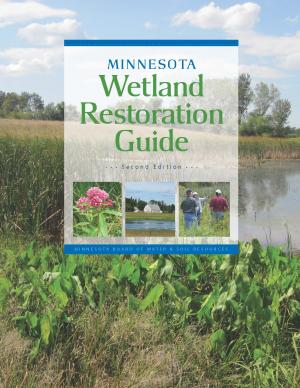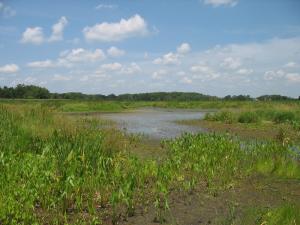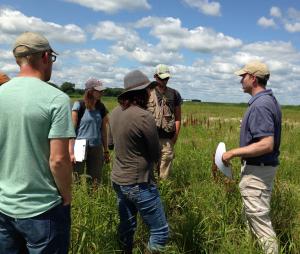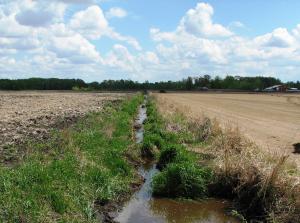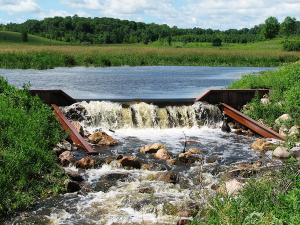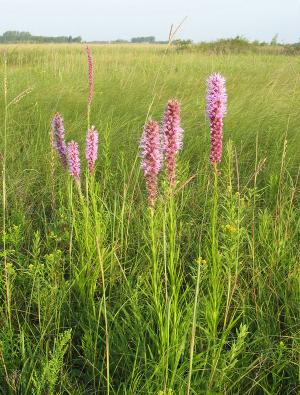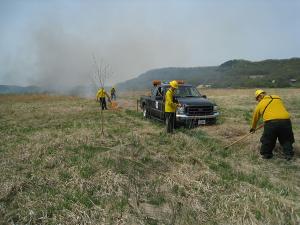Welcome to the “Minnesota Wetland Restoration Guide” web site. This site is designed to provide easy access to the contents of the Guide, whether the user chooses to view it online or print it out as a reference document.
The Minnesota Wetland Restoration Guide is a comprehensive multidisciplinary document that offers sound engineering and ecological principals for restoring and creating functional and sustainable wetlands in Minnesota.
The Minnesota Board of Water and Soil Resources intends to keep the Minnesota Wetland Restoration Guide updated as new research, restoration strategies, and practitioner information becomes available. Input regarding the content of the Guide is welcomed and will be considered as part of future updates.
-
Introduction
-
A “Minnesota Wetland Restoration Guide” was first published in December 1992 by the Minnesota Board of Water and Soil Resources (BWSR). This Guide had an emphasis on engineering design and provided technical guidance for restoring drained wetlands and their management. In more recent years BWSR has published additional guidance on restoring drained wetlands including establishing vegetation as part of restoration projects.
Information from these prior documents along with new concepts, strategies, and techniques are incorporated into the new, updated Minnesota Wetland Restoration Guide. Included is information from updated research and hands-on experience of practitioners from across the state. The result is a comprehensive multidisciplinary document that offers sound engineering and ecological principals for restoring and creating functional and sustainable wetlands in Minnesota.
This section of the Minnesota Wetland Restoration Guide discusses the purpose and scope of the document, describes its organization and use, and lists and acknowledges its principal authors and development staff.
MN Wetland Restoration Guide - Cover Page (pdf)
Introduction (pdf)
Additional Resources
-
Planning
-
Each agency and organization with wetland restoration programs in Minnesota have specific requirements that influence the process of evaluating and selecting projects for funding. Careful planning is required to match potential projects with available programs and opportunities.
The selection of goals, objectives and outcomes for projects also play a key role in the planning process. Broad program goals are most often driven by the agency, organization, or program for which a potential project will be completed. The primary goals for conducting most wetland restoration or creation projects are providing wildlife habitat, improving water quality, and providing flood protection. A focus on any one of these three primary goals will influence the selection process used to identify potential projects. Identifying project objectives, outcomes and associated performance standards helps focus the restoration strategies and monitoring methods to be used at a site.
This section of the Minnesota Wetland Restoration Guide discusses the initial steps in planning and identifying a wetland restoration or creation project including the identification and evaluation of projects, and establishing project goals, objectives, and measurable outcomes.
MN Wetland Restoration Guide - Section 2: Planning (pdf)
Additional Resources
-
Site Assessment and Evaluation
-
All wetland restorations depend on a suitable site to meet intended project goals. Successful projects take advantage of unique project characteristics while overcoming identified drawbacks or obstacles. The collection and assessment of site information is important to understanding both the available opportunities, as well as potential limitations for restoration.
This section of the Minnesota Wetland Restoration Guide discusses the process to assess and evaluate a potential wetland restoration project. It includes discussion on the methods and procedures used to investigate and collect important site information and describe the importance of this information to the overall project evaluation. Included are considerations of varying program policies, project goals, scope, legal considerations, and restoration complexity and their effect on the assessment and evaluation process.
Each potential restoration site is unique. Not every component discussed in this section of the Guide needs to be assessed and evaluated at each project site. Conversely, the assessment of additional components not discussed in the Guide may be warranted depending on the project and specific site conditions. Nonetheless, the design and implementation of the pending restoration will rely on the thoroughness of the site assessment and data collection effort. Expending the time and effort to conduct a thorough site assessment will provide for identification of all restoration opportunities and increases the chances for project success. More importantly perhaps, it allows impractical or costly sites to be avoided or at the very least, allows the project manager or owner to proceed with a full understanding of restoration challenges and potential costs.
MN Wetland Restoration Guide - Section 3: Site Assessment and Evaluation (pdf)
Section 3 - Appendices
Additional Resources
-
Engineering Design and Construction
-
Achieving a functioning wetland that mimics natural wetlands should be the goal of every wetland restoration. Restoration success requires careful consideration to the engineering design and construction needs of a project.
A primary goal of the Engineering Design and Construction Section of the Minnesota Wetland Restoration Guide is to provide current and reliable information about engineering analyses and design principles that can be used to address a variety of wetland drainage and alteration scenarios common across much of Minnesota’s landscape. The design strategies and construction processes presented are targeted toward achieving functional and sustainable wetland restorations. The information presented uses accepted engineering design standards and practices which follow hand-in-hand with consideration to the safety and welfare of the public and surrounding infrastructure.
Individual chapters address design considerations for hydrology and hydraulics, restoration strategies, outlet structures, and other important project features. Other chapters address considerations for preparing construction plans, specifications, and contracts, along with information about wetland and construction related permits and regulations. Finally, information is provided about construction implementation including: hiring contractors, staking and laying out construction plan components, inspecting the work of contractors during the construction work, and performing final project inspections and certifications.
MN Wetland Restoration Guide - Section 4: Engineering Design and Construction (pdf)
Section 4 - Appendices
- 4A-1 Blocking and Filling Surface Drainage Ditches (pdf)
- 4A-2 Blocking Subsurface Drain Tile (pdf)
- 4A-3 Outletting Drainage Systems (pdf)
- 4A-4 Rerouting Drainage Systems (pdf)
- 4A-5 Removing/Relocating Drainage Lift Stations (pdf)
- 4B Standard Engineering Design Drawings -- see Guidance Documents
- 4C Construction Permit Compliance Checklist (pdf)
- 4D Pre-Construction Meeting Agenda (pdf)
- 4E Sample Inspection Plan (pdf)
- 4F Sample Change Order Form (pdf)
-
Vegetation Establishment
-
The practice of establishing vegetation in wetlands and surrounding buffer areas continues to evolve as restoration professionals gain a better understanding about how to establish and managing native plant communities. In recent years, there has been a greater emphasis on maximizing landscape functions such as developing stable habitats for a wide variety of wildlife species, diversifying plant communities, providing competition for invasive plants, and using vegetation to help address soil and water resource issues. Focusing on ecosystem functions has led to the development of new strategies and techniques to manage invasive species, plant upland and wetland vegetation, and provide long-term care.
The Vegetation Establishment Section of the Minnesota Wetland Restoration Guide provides a comprehensive approach to establishing native vegetation as part of restoring both drained wetlands and their surrounding upland buffers. The chapters in this section of the Guide include detailed information about the steps involved in preparing a site for restoration, selecting seed mixes, developing a vegetation establishment plan, and establishing and maintaining plant communities.
A primary goal of the Vegetation Establishment Section of the Guide is to provide information on current methods to restore and maintain vegetation in wetlands and surrounding uplands to help practitioners successfully achieve project goals, and ultimately advance the field of wetland restoration.
MN Wetland Restoration Guide - Section 5: Vegetation Establishment (pdf)
Section 5 - Appendices
- 5-A Technical Guidance Documents - see Guidance Documents
- 5-B Invasive Species Control (pdf)
- 5-C Project Specifications (pdf)
- 5-D Restoration Details / Diagrams (pdf)
- 5-E Seedbank Testing Protocol (pdf)
- 5-F Plant Community Tables (pdf)
- 5-G Vegetation Establishment Tables (pdf)
- 5-H Wetland Vegetation Establishment Research Needs (pdf)
- 5-I Plant Information Links (pdf)
- 5-J Vegetation Plan Examples (pdf)
- 5-K Citations (pdf)
Additional Resources
-
Site Management and Monitoring
-
Wetlands are dynamic ecosystems that slowly change and evolve in response to natural processes. The development of sustainable, functional ecosystems can take years of active management before they truly represent natural systems. Thorough management plans and proper management strategies encourage species diversity and allow for successional development of these wetlands and surrounding upland vegetative buffers within the shortest time frame possible. Project monitoring also plays a key role in the restoration process by guiding decision making about when, and how site maintenance strategies should be implemented. Effective monitoring plans provide information relevant to project goals, anticipated outcomes, and maintenance strategies used.
A primary goal of this section of the Guide is to provide a basic level of understanding of long-term site management along with a discussion of maintenance strategies that can be used to successfully manage restored and created wetland sites and upland buffers. The Guide also recommends site monitoring schedules and checklists for routine inspections and provides information for more advanced site monitoring that allows for measurement of specific goals, objectives, and project outcomes or performance standards.
MN Wetland Restoration Guide - Section 6: Site Management and Monitoring (pdf)
Section 6 - Appendices
- 6-A Technical Guidance Documents - see Guidance Documents

